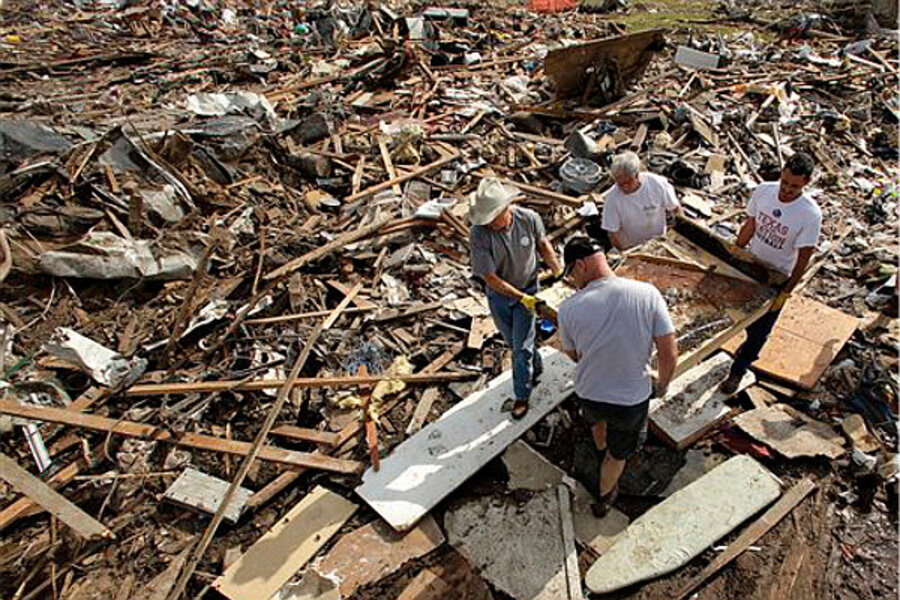Oklahoma tornado debris could pile a mile high: Obama promises help
Loading...
| MOORE, Okla.
Before residents of Moore can rebuild, they'll have to deal with the debris from the deadly tornado that devastated the Oklahoma City suburb: crushed wood, mangled siding and battered belongings that could make a pile reaching more than a mile into the sky.
The splintered remains' first stop is a landfill where items will be sorted, then recycled or burned. Bricks, for instance, will go to charity projects such as Habitat for Humanity; wood, paper and clothing will be incinerated.
"I could be sad about it, but it's not going to make anything come back. It's just a house. It's just stuff. We have each other," Jessie Childs said as bulldozer and backhoe operators reduced her house near the Plaza Towers Elementary School to a 10-foot pile of rubble.
The school was destroyed in the top-of-the scale EF5 tornado that carved a 17-mile path of destruction on May 20. In all, 24 people were killed, including seven children in the school.
With each load of debris, Moore moves another step closer to recovering from the storm that damaged or destroyed 4,000 homes and businesses. Against a cacophony of snapping lumber, crunching metal and the beep-beep of bulldozers in reverse, Clayton Powell sorted through the listing remains of his Moore home.
"You're sifting through rubble piles trying to find that one photo, memories you can't restore," Powell said. "I'm sure there are a few things I haven't even thought of and won't miss."
Presidential approval of a major disaster declaration typically covers 75 percent of the cost for communities to remove debris. In Moore's case, President Barack Obama approved even more assistance. Under a pilot program, the federal government will pay 85 percent of debris removal costs for the first 30 days and 80 percent for the next 60. The expectation is that quicker debris removal speeds up the overall recovery.
The Oklahoma Department of Transportation brought in 400 of its workers and 250 pieces of equipment, including dump trucks and front-end loaders, to help with the process, said Transportation Secretary Gary Ridley.
As residents pick through the remains of their homes for the few surviving personal treasures, they've developed a way for crews to know when it's OK to take stuff away. "If it's out on the curb, anybody can come out and get it," said Charlie Baker of Blanchard, watching a bulldozer raze his daughter's house and push it to the street.
A relative found her Tiffany necklace, but there's not much else worth salvaging. Jumping into the pile quickly after the storm, Kathy Duffy struggled to even find things that actually belonged to her sister, who was out of town when the storm hit.
"None of the clothes we found is theirs. None of the pictures we found is theirs," Duffy said last week. "That's definitely not theirs," she said, pointing to a pair of large black sweatpants draped over a chair.
Paul Borges, who lives on the east side of Moore, found a crowbar and a 1979 baseball card featuring a player he had never heard of. A neighbor found one-half of a $100 bill. A field near the Abundant Life church was littered with canceled checks from 1980 — and from a town 16 miles away. Along Eagle Street was a pink, fuzzy slipper and a gray bra, with no sign they traveled together.
After debris arrives at the landfill, workers will go through it, Moore Mayor Glenn Lewis said. Wood, paper and clothing will be placed in a "burner box," a device that uses its own scraps to generate heat to the point that it eventually consumes itself, Lewis said. Hazardous material will likely go out of state.
Albert Ashwood, Oklahoma's emergency management director, could not estimate the cost or the amount of the debris beyond "I can tell you there will be plenty." His agency on Monday estimated that just under 4,000 homes and businesses were destroyed or seriously impacted by storms May 19 and 20 — a figure about half that from a similar EF5 tornado in Joplin, Mo., two years ago.
The Missouri storm generated 3 million cubic yards of debris. If Moore's debris field winds up about half that, the pile would cover an NBA-sized basketball court, like the one where the Oklahoma City Thunder play, to a depth of 1.7 miles.
Not everything will be taken away, however, either by accident or by design.
At a slab on a street behind the Plaza Towers school, the heaviest debris was already on its way to the landfill. Left behind were dining room chairs and an interesting collection of videotapes: "Twister" (but not the Helen Hunt version), a documentary "Real Stories of Tornadoes" and the children's thriller "Something Wicked This Way Comes."
Associated Press writers Justin Juozapavicius, Ramit Plushnick-Masti and Nedra Pickler contributed to this report.







